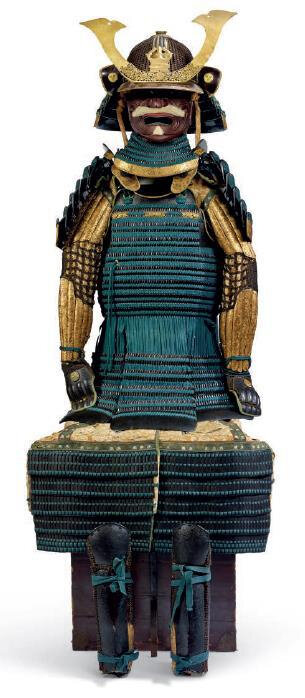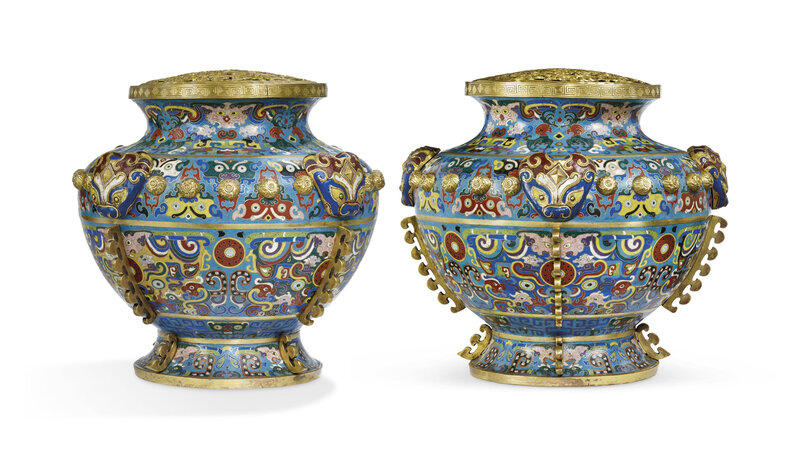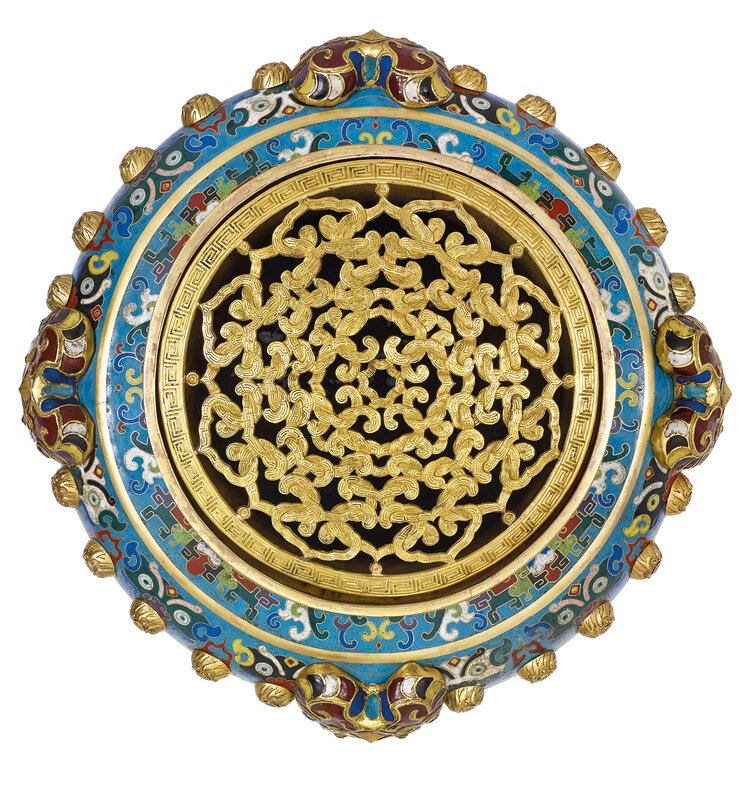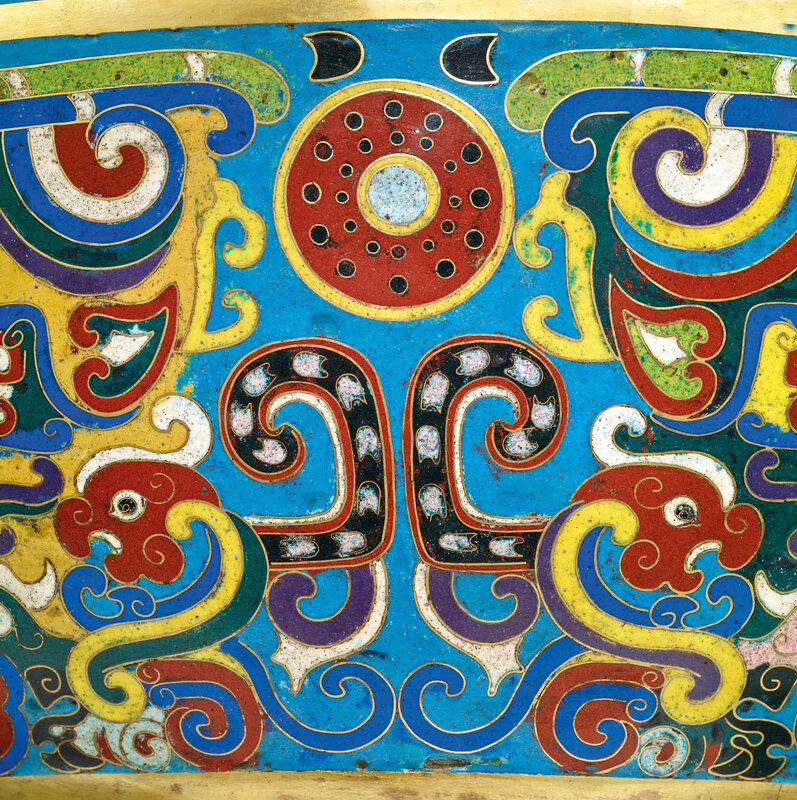Christie's Paris announces sale of Asian Art including the prestigious collection of Lionel Fournier
Lot 108. A rare and important massive imperial cloisonné enamel ‘taotie’ vase and cover, lei, China, Qing dynasty, Qianlong period (1736-1795). Estimate €150,000-200,000. Price realised EUR 343,500. © Christie’s Images Limited 2018.
PARIS.- On 12 December, the Asian Art department will present a sale offering 205 lots mainly coming from European private collections. The sale, estimated 4 to 6 million euros, will include 74 pieces coming from the prestigious collection of Lionel Fournier, a section dedicated to South-Eastern pieces and a beautiful group of Chinese jades coming from a private French collection.
Lionel Fournier was a pioneer in celebrating esoteric Himalayan art. Indeed, when he pursued the family business of selling luxurious skins to prestigious fashion designers, he discovered Eastern Asian countries and their beautiful artistic production. Over the years, Fournier started to acquire several Asian art pieces and more specifically Tibetan, Himalayan and Nepalese works of art such as Thangkas, manuscripts, stone statues and bronzes figures. Fournier did numerous donations to the Musée Guimet which collections have tremendously enlarged thanks to him. Some pieces from the sale have been exhibited for several years at the Musée Guimet until Fournier’s passing. The sale will present some gilt-bronze Tibetan sculptures such as a figure of Samvara (estimate: €60,000-80,000) and a figure of Vajradhara from the 15th century (estimate: €60,000-90,000), as well as another 15th century gold-inlaid silver figure of Hevajra (estimate: €80,000-120,000). Two important Thangkas are also part of this fabulous collection including one representing the mandala of Vajravarahi (estimate: €400,000-600,000).

Lot 26. A Tibetan gilt-bronze figure of Vajradhara, 15th century. Estimate: €60,000-90,000. Price realised EUR 106,250. © Christie’s Images Limited 2018.
Lot 13. A Tibetan thangka mandala of Vajravarahi, Tibet, 13th century. Dimensions: 42,5 x 35,5 cm. (16 ¾ x 14 in.) Estimate: €400,000-600,000. Price realised EUR 607,500. © Christie’s Images Limited 2018.
Elle est représentée au centre piétinant un corps humain. Sa main droite tient lekarttrika, sa main gauche le kapala, le bâton reposant contre son épaule. Elle porte une jupe de perles autour de la taille. Elle est parée d'un mala de têtes coupées et de colliers divers. L'expression de son visage est sévère, une tête de sanglier à droite de sa tête. Elle est entourée par des assistantes. Le registre supérieur est à décor de lamas,mahasiddhas et Vajradhara, la section inférieure rehaussée de cinq divinités et un donateur. Le dos porte une inscription, encadré.
Provenance: The Private Collection of Lionel and Danielle Fournier of Himalayan Art, collected in Europe during 1970s-1980s.
Literature: G. Béguin, Art ésotérique de l'Himâlaya : La donation Lionel Fournier, Réunion des musées nationaux, Paris 1990, p. 173.
Exhibited: Musée national des arts asiatiques - Guimet, 13 October 1990 - 28 January 1991.
Note: This important early painting portrays Vajravarahi or the ‘Diamond Sow’ in a striking double triangle situated within a band of lotus petals and flames, forming the outer border of her mandala. Her blue painted sow-head that emerges from the right side of her head is associated with overcoming ignorance. This is accentuated by her dancing posture where she tramples on a figure which represents again her triumph over ignorance. With her right hand she brandishes the ritual chopper while her left holds the skull cup. A ceremonial staff is placed against her shoulder. Surrounding her, both within and outside the six-pointed star, are her assistants. The four corners see the cremation grounds separated by eight rivers. Interestingly, the official eight grounds are here not executed according to prescribed iconographic texts but show a free interpretation as just four of them are represented.
The lower register depicts five deities with their consorts in sexual union. According to Gilles Béguin they most likely present Samvara and his consort Vajravarahi. The author discusses this painting in length in his publication on page 172. A seated monk in front of an offering-set occupies its lower right corner. The upper register depicts various historical figures linked to bKa brgyud pa order, headed by the blue Adi Buddha Vajradhara. These are from left to right Tilopa (ca. 988 - ca. 1069), Naropa (ca. 956 - ca. 1040), Marpa (1012 - 1096), Milarepa (1040 - 1123), sGam po pa (1079 - 1153), Phag mo gru pa (1110 - 1170) and most likely Thang pa Chen po (1142 - 1210), who founded the Taklung monastery in 1180.
Tiphaine Nicoul, Director of the Asian Art department: “We are honoured to have been entrusted with the sale of the remarkable collection of Lionel Fournier. It is such a privilege to be able to offer works of art of this quality gathered for decades by a man who dedicated his life to the promotion of Asian Art. Collectors, who are always keen to acquire pieces from prestigious provenance will certainly be attracted by these rare and remarkable works of art”.
The department will also present a very rare and exceptional imperial cloisonné enamel Taotie vase and cover (estimate: €150,000-200,000. This vase, coming from a French private collection, is very close to another lei vessel of the same size and almost the same design which is today part of the Musée des Arts décoratifs’ collections. These similarities could suggest that these two vases were made to be matched as a pair during the Qianlong emperor’s reign.
As early as the 19th century, the cloisonné enamel vessels in particular were a great source of inspiration to the European decorative arts. The lei of the Musée des Arts décoratifs was donated by Mrs Alexandrine Louise Grandjean in 1923 along with many pieces after she deceased in 1911. Her whole collection was essentially formed in the late 19th century. Like Mrs Grandjean’s vase, our present lei vase was probably brought to Europe by the beginning of the 20th century.

Lot 108. A rare and important massive imperial cloisonné enamel ‘taotie’ vase and cover, lei, China, Qing dynasty, Qianlong period (1736-1795); Hauteur: 45 cm. (17 ¾ in.). Estimate €150,000-200,000. Price realised EUR 343,500. © Christie’s Images Limited 2018.
De forme balustre, la panse et le pied sont rehaussés d'arêtes crénelées en bronze doré. La partie centrale est ornée d'un large registre à décor de masques de taotie, dragonskui, disques bi, animaux fabuleux stylisés et volutes. L'épaulement est rehaussé de quatre masques de chimères en relief, alternant avec des clous dorés et ciselés également en relief et disposés entre deux frises de taotie. La bordure du col est à décor de grecques incisées. Le couvercle ajouré est composé d'un enchevêtrement élaboré de volutes en cuivre doré, repoussé et ciselé ; petites restaurations.
Provenance: Previously in a Belgian and then in a French private collection.
Note: The Qing dynasty emperors shared a fervent passion for ancient bronzes and for ordering contemporary vessels made in similar style. The Kangxi (1662-1722), Yongzheng (1723-35) and Qianlong (1736-95) emperors in particular were important collectors of antiques and great patrons of the arts. The Qianlong emperor, like his predecessor Song Huizong, commissioned numerous catalogues illustrating pieces of his collection, including the Xi Qing gu jian (Mirror of Antiquities [prepared in] the Xi Qing [hall], which was compiled in 1749 and recorded ancient bronzes of the Imperial collection.
A cloisonné Lei vessel of the same size and almost the same design to the current example is in the collection of the musée des Arts décoratifs, Paris (fig.1), illustrated by Beatrice Quette (ed.) in Cloisonné: Chinese Enamels from the Yuan, Ming and Qing Dynasties, Bard Graduate Center, New York, 2011, p. 99, fig. 5.31. The close similarities of the design and the colour scheme could suggest that they were made to be matched as a pair during the Qianlong emperor’s reign.
In the 1860s, Chinese art pieces were very popular in Europe. The cloisonne enamel vessels in particular were a great source of inspiration to the European deocrative arts. The lei of the musée des Arts décoratifs was donated by Mrs Alexandrine Louise Grandjean in 1923 along with a large number of pieces after she deceased in 1911. Her whole collection was essentially formed in the late 19th century. Like Mrs Grandjean’s vase, our present lei vase was probably brought to Europe by the beginning of the 20th century. See another imperial lei of the same size but with a slightly different colour scheme, from the collection of Juan Jose Amezaga, sold in Christie’s Paris, 13 June 2007, lot 25.
The Asian art department is pleased to offer a beautiful French collection of Chinese jades at auction. These remarkable pieces have been collected by a French family in the 1930’s. The highlight of this amazing group is a bridge-form brush rest carved in white jade from the Qing dynasty (18th – 19th century). The details present in this piece prove the talent and dexterity of the artist. White jade has always been considered as the most precious, rare and beautiful stone by Chinese Emperors as they believed in the positive and divine forces that it contains. Its hardness symbolizes intelligence and authority, all qualities attributed to the Emperor (estimate: €80,000-120,000). A white jade Mughal-style cup representing a ram will also be including in this collection. From the 18th-19th century Qing dynasty, this cup is estimated at €30,000-50,000.
Lot 117. A white jade bridge-form brush rest, Qing dynasty, 18th – 19th century. Estimate €80,000-120,000. Price realised EUR 487,500. © Christie’s Images Limited 2018.
Le pont délicatement sculpté est peuplé de paysans sur des ânes, il enjambe une rivière où se tient un marché flottant rassemblant plusieurs embarcations légères, le socle en jade vert épinard sculpté d'eaux ondoyantes. Longueur du pont: 20 cm. (7 7/8 in.). Longueur du socle: 21,5 cm. (8 ½ in.)
Provenance: French private collection, acquired by the grand-father of the present owner in France in the 1920s.
Note: This exquisite white jade brush rest depicting a vivid scene figuring farmers and horses crossing a arched bridge overlooking four boats of a floating market is one of the finest examples which fully embodies the delicacy and creativity of craftsmanship under the Empereur Qianlong's reign. This rare white jade 'bridge' brush rest seems to be the only exemple with its original spinach green jade base decorated with rocks and waves.
Carved jades such as this present piece represent miniature idealised landscapes upon which the scholar-collector could contemplate and escape. As R. Kleiner mentions in Chinese Jades from the Collection of Alan and Simone Hartman, Hong Kong, 1996, p. 160, "they complement the miniature gardens and trees cultivated by most scholars.".
Compare with a extremely similar white jade brush rest nevertheless without its original base in the collection of the Palace Museum, Beijing, illustrated in The Complete Collection of Treasures of the Palace Museum: Jadeware (III), Hong Kong, 1995, p. 195, no. 159.
Along with the 160th anniversary of the French and Japanese diplomatic relationships, the department dedicated a section to Japanese art. Amongst the highlights of this section, international collectors will discover a beautiful Japanese screen from the 17th century composed of six panels, representing a landscape with large white linen drying in the sun (estimate: €30,000-50,000) and a blue-laced suit of armor from the Edo period, 18th century estimated at €12,000-18,000.

A blue-laced suit of armor, Edo period, 18th century. Estimate €12,000-18,000. © Christie’s Images Limited 2018.
A small but important collection of Shunga (Japanese erotic prints) will also be offered to the connoisseurs. Coming from a private collection, it includes a rare 18th century handscroll for the sleeve (sode no maki) by Torii Kiyonaga (€120,000-150,000).
Also part of this sale are two important Guanyin figures including one from the Yuan dynasty. This statue is in Qingbai ware, a rare Chinese porcelain produced under the Song and the Yuan dynasties, defined by the ceramic glaze used. This porcelain is white with a blue-greenish tint, and is also referred to as Yingqing (estimate: €80,000-120,000). This graceful bodhisattva combines inherent serenity with an expression of infinite compassion. The figure sits in the relaxed attitude of ‘royal ease’ rājalīlāsana, with the left arm straight at the side of the figure and the hand resting lightly on the floor. The face has a gentle expression, with the eyes downcast and the mouth forming a tender smile. Buddhist figures of the Yuan dynasty, made in porcelain and covered with a qingbai glaze, developed from the tradition of finely-modelled religious figures made at the Jingdezhen kilns during the Southern Song period (1127-1279). There is a very small extant group of these Song figures in international collections. Inscriptions and the date of tombs inwhich these figures have been found suggest that they were made in the second and third quarters of the 13th century - just prior to the Mongol conquest.

A Qingbai figure of Guanyin, Southern Song-Yuan dynasty, 13th century. Estimate €80,000-120,000. © Christie’s Images Limited 2018.

/https%3A%2F%2Fprofilepics.canalblog.com%2Fprofilepics%2F1%2F0%2F100183.jpg)
/https%3A%2F%2Fstorage.canalblog.com%2F03%2F02%2F119589%2F96711876_o.jpg)
/https%3A%2F%2Fstorage.canalblog.com%2F11%2F31%2F119589%2F94773502_o.jpg)
/https%3A%2F%2Fstorage.canalblog.com%2F20%2F83%2F119589%2F94772815_o.jpg)
/https%3A%2F%2Fstorage.canalblog.com%2F26%2F72%2F119589%2F75604929_o.jpg)
/https%3A%2F%2Fstorage.canalblog.com%2F59%2F60%2F119589%2F26458628_o.jpg)









/image%2F1371349%2F20240425%2Fob_c453b7_439605604-1657274835042529-47869416345.jpg)
/image%2F1371349%2F20240425%2Fob_59c6f0_440358655-1657722021664477-71089985267.jpg)
/image%2F1371349%2F20240425%2Fob_07a28e_440353390-1657720444997968-29046181244.jpg)
/image%2F1371349%2F20240425%2Fob_0b83fb_440387817-1657715464998466-20094023921.jpg)